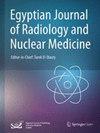Impact of body mass index on the relationship of Epicardial fat volume to coronary artery disease in males
IF 0.5
Q4 RADIOLOGY, NUCLEAR MEDICINE & MEDICAL IMAGING
Egyptian Journal of Radiology and Nuclear Medicine
Pub Date : 2024-08-12
DOI:10.1186/s43055-024-01303-1
引用次数: 0
Abstract
Epicardial fat tissue refers to a type of visceral fat tissue that envelops the myocardial and visceral pericardium. It is recognized as a novel risk sign for cardiovascular issues, including coronary artery disease, our aim to assess the influence of body mass index on the amount of epicardial fat volume and its association with coronary artery disease in male patients. Epicardial fat volume was quantified using cardiac Computed tomography scans in a cohort of 119 male patients who were believed to have coronary artery disease. Patients were categorized into three groups based on their body mass index values: Group I Body Mass Index (BMI ≥ 18.5–24.9 kg/m2), Group II (BMI ≥ 25–29.9 kg/m2), and Group III (BMI ≥ 30 kg/m2). In Group I, there were twenty-three patients (19.3%) with a mean epicardial fat volume of 40 ± .42.8 ml. In Group II, there were forty-three patients (36%) with a mean Epicardial Fat Volume (EFV) of 56 ± 21.5 ml. In Group III, there were 53 patients (44%) with a mean EFV of 56 ± 15.8 ml, when compared to the results of Group I, which were considerably higher (p = 0.0004). Regarding prevalence of obstructive coronary artery disease in our patient population, 86 individuals (72.3%) were diagnosed with obstructive coronary artery disease and exhibited a tendency to have a greater value of epicardial fat volume at 56.4 ± 18.9 ml, with a range of 19–121 ml, compared to those without coronary artery disease at 45.2 ± 6.7 ml, with a range of 33–55 ml (P < 0.02). The prevalence of coronary artery disease was 85% in group III and 87% in group II. Patients in group III with coronary artery disease exhibited a substantially higher EFV of 46 ± 6.63 vs 16 ± 3.2 ml (p = 0.001) compared to those without obstructive coronary artery disease. Although epicardial fat volume was elevated in patients with coronary artery disease independent of their BMI, the predictive ability of epicardial fat volume for coronary artery disease was more pronounced in individuals with a body mass index more than 25 kg/m2.体重指数对心外膜脂肪量与男性冠状动脉疾病关系的影响
心外膜脂肪组织是指包裹心肌和内脏心包的一种内脏脂肪组织。我们的目的是评估体重指数对男性患者心外膜脂肪量的影响及其与冠心病的关系。我们使用心脏计算机断层扫描对一组 119 名据信患有冠状动脉疾病的男性患者的心外膜脂肪量进行了量化。根据体重指数值将患者分为三组:第一组体重指数(BMI ≥ 18.5-24.9 kg/m2)、第二组(BMI ≥ 25-29.9 kg/m2)和第三组(BMI ≥ 30 kg/m2)。第一组有 23 名患者(19.3%),平均心外膜脂肪量为 40 ± .42.8 毫升。第二组有 43 名患者(36%),平均心外膜脂肪量(EFV)为 56 ± 21.5 毫升。第三组有 53 名患者(44%),平均心外膜脂肪体积(EFV)为 56 ± 15.8 毫升,与第一组的结果相比高出很多(p = 0.0004)。关于阻塞性冠状动脉疾病在我们的患者群体中的患病率,86 人(72.3%)被诊断为阻塞性冠状动脉疾病,与无冠状动脉疾病的患者(45.2 ± 6.7 ml,范围为 33-55 ml)相比,心外膜脂肪体积的值有增大的趋势,为 56.4 ± 18.9 ml,范围为 19-121 ml(P < 0.02)。冠状动脉疾病的发病率在 III 组为 85%,II 组为 87%。与无阻塞性冠状动脉疾病的患者相比,患有冠状动脉疾病的 III 组患者的 EFV 高出很多,分别为 46 ± 6.63 与 16 ± 3.2 毫升(P = 0.001)。虽然冠心病患者的心外膜脂肪体积升高与体重指数无关,但体重指数超过 25 kg/m2 的人的心外膜脂肪体积对冠心病的预测能力更强。
本文章由计算机程序翻译,如有差异,请以英文原文为准。
求助全文
约1分钟内获得全文
求助全文
来源期刊

Egyptian Journal of Radiology and Nuclear Medicine
Medicine-Radiology, Nuclear Medicine and Imaging
CiteScore
1.70
自引率
10.00%
发文量
233
审稿时长
27 weeks
 求助内容:
求助内容: 应助结果提醒方式:
应助结果提醒方式:


